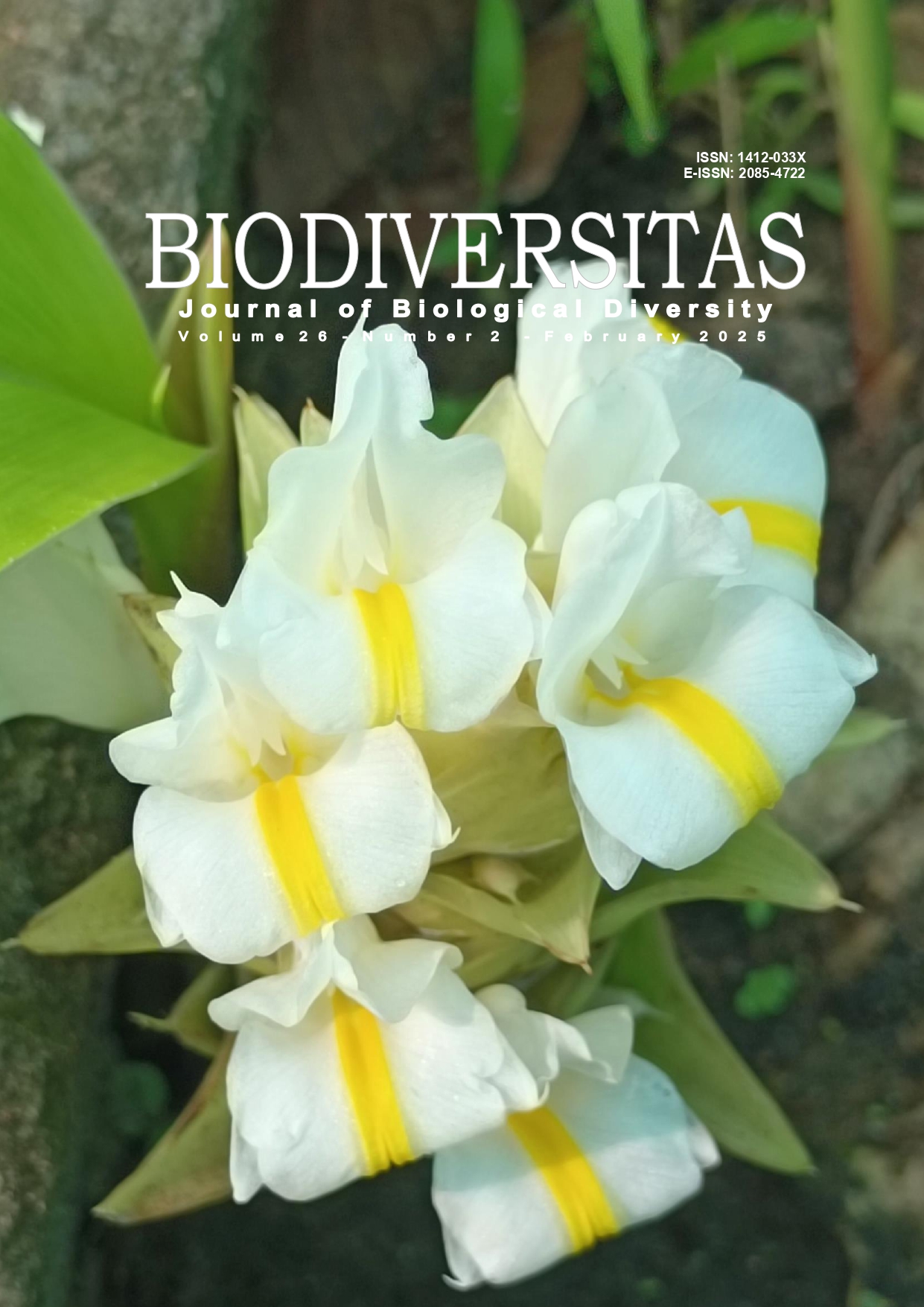Butterfly diversity along an altitudinal gradient and land uses in East Java, Indonesia
##plugins.themes.bootstrap3.article.main##
Abstract
Abstract. Leksono AS, Yanuwiadi B, Millah N, Abdullah SA. 2025. Butterfly diversity along an altitudinal gradient and land uses in East Java, Indonesia. Biodiversitas 26: 551-563. Butterflies are a group of insects that are vulnerable to disturbances due to changes in land use. Land-use changes due to human activities can have negative impacts on insects, including butterflies. This study aims to analyze butterfly diversity at different elevations and land uses in Lumajang, East Java, Indonesia. Butterfly diversity was surveyed using an active visual survey method by adopting Pollard Walk transect. The samplings were made for three months (August to October 2022) in seven sites along an altitudinal gradient. The characteristics of butterfly assemblages in East Java were analyzed in terms of the number of individuals, the species richness, and Shannon's diversity index. A total of 3099 individual butterflies belong to 123 species and six families were observed in seven locations. The abundance of butterflies varied among study sites. The highest species richness and diversity were found in Ranu Bedali, representing forest/plantation areas in lower altitudes, while the lowest was found in Kandangtepus representing an area dominated by arable land. The abundance, species richness, and diversity across elevation and land use differ significantly between locations. In general temperature, light intensity and forests or plantations had positives effect on butterfly abundance, richness, diversity and composition, while humidity, altitude, shrubs or grasses, and agriculture land had negative influences on those butterfly parameters.
##plugins.themes.bootstrap3.article.details##
Most read articles by the same author(s)
- AMIN SETYO LEKSONO, BAGYO YANUWIADI, AINUL KHOTIMAH, ANISA ZAIRINA, Grasshopper diversity in several agricultural areas and savannas in Dompu, Sumbawa Island, Indonesia , Biodiversitas Journal of Biological Diversity: Vol. 23 No. 1 (2022)
- AMIN SETYO LEKSONO, BAGYO YANUWIADI, AMINUDIN AFANDHI, MOHAMMAD FARHAN, ANISA ZAIRINA, The abundance and diversity of grasshopper communities in relation to elevation and land use in Malang, Indonesia , Biodiversitas Journal of Biological Diversity: Vol. 21 No. 12 (2020)
- YUNITA FERA RAHMAWATI, AMIN SETYO LEKSONO, AKHMAD RIZALI, ZULFAIDAH PENATA GAMA, Population dynamics of Bactrocera spp., and parasitization efficacy of Opius sp. (Hymenoptera: Braconidae) in citrus varieties , Biodiversitas Journal of Biological Diversity: Vol. 25 No. 11 (2024)
- AMINUDIN AFANDHI, ELYKA PUTRI PERTIWI, DICKY PREJEKI PURBA, TITA WIDJAYANTI, AMIN SETYO LEKSONO, The diversity of entomopathogenic fungi collected from leaves and rhizospheres of rice implementing integrated pest management , Biodiversitas Journal of Biological Diversity: Vol. 21 No. 6 (2020)
- FOUAD FAUZI, SUEMARNO, AMINUDIN AFANDHI, AMIN SETYO LEKSONO, Nesting behavior of Bornean immature Orangutan (Pongo pygmaeus wurmbii) in Nyaru Menteng Arboretum School, Palangka Raya, Central Kalimantan, Indonesia , Biodiversitas Journal of Biological Diversity: Vol. 21 No. 5 (2020)
- MUHAMAD AZMI DWI SUSANTO, ZULFAIDAH PENATA GAMA, AMIN SETYO LEKSONO, Habitat characteristics and threats of little-known endemic dragonfly, Neurothemis feralis (Burmeister, 1839) (Odonata: Libellulidae) in East Java, Indonesia , Biodiversitas Journal of Biological Diversity: Vol. 25 No. 7 (2024)
- BUDI PURWANTININGSIH, AMIN SETYO LEKSONO, BAGYO YANUWIYADI, ZULFAIDAH PENATA GAMA, SAIFUL ARIF ABDULLAH, Diversity, abundance, and ecological roles of insect pollinators in red guava flowers (Psidium guajava) in East Java, Indonesia , Biodiversitas Journal of Biological Diversity: Vol. 16 No. 3 (2025)

